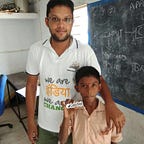How I #teachtheweb to rural kids
I am cross posting this story from one of my old blog posts written few years back during my involvement in Mozilla & Mozilla Learning initiative “Maker Party”. We also actively use this method at our CoderDojo Foundation ☯ CoderDojo Dublin classes too.
In rural areas, if you are hosting a computer training session the reality is not everyone children would seen a real computer earlier. In such cases, it is very important to make learners understand “What a computer is” to some extent before talking about the “Web”.
Kids seeing computer for the first time surely will not understand anything when we define computer as, “Electronic device capable of doing arithmetic and logical expressions”.
Here is what we do,
- To make kids realize, computer is an electronic device we turn off the power switch once the desktop is loaded
- Now raise appropriate question to make kids list out similar equipment in their household which will not work without power — this will make kids to relate to computer with fan, light, TV, etc..,
- It’s time to make kids understand the computing and logical power of the computer.
- We ask simple mathematical equation like, 1+1 , 10+12. We get answers in flash of seconds. We slowly given then bigger numbers like 1342+6723 which require time and use of pen and paper to come up with answer.
- At that point, we use calculator application on desktop and show how fast computer can solve complex questions — this will give the realization that computer can perform complex calculations in seconds.
- Next, we instruct kids to draw circle and rectangle on a sheet of paper. It’s not going to be a perfect one. Open Paint app and show with computer you can draw perfect shapes in seconds.
- At this point, kids know that computer is an electronic device capable of making calculations and drawings in less time with perfection.
After this, we are set to make a move to Internet.
- Start by making kids to sit in a random manner and number them. Say, 10 kids so from 1 to 10.
- Call the kid numbered with one and ask him to find the name of kid numbered with 10.
- Kid with no.1 will pass the question secretly to no.2 and no.2 to no.3 it continues until it reaches the no.10
- no.10 will then pass the answer to no. 9 and no. 9 to no. 8 it continuous until the answers reaches no.1 who will then communicate to the questioner.
- Then, we explain that initial questioner is the user who uses the computer.
- Kid numbered 1 is the web browser and from 2 to 10 are computers located in different places but can share information with one another.
We found this activity gave the kids an understanding of Internet as “group of interconnected computers than can share information requested by the user through a web browser.
Next up, how do we help kids relate “URL”
- Just ask how do they introduce them to others — surely, they say with their names
- Similarly, to get the required information we need to use the name of it in a certain format like www.name.com
- That format together with the name is called as URL.
We found positive results during our post-session assessment where kids got the basic understanding of a computer, internet and url.
Thanks for reading. Let us know if you have any thoughts.
